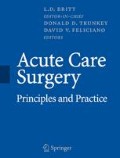Abstract
A 66-year-old retired teacher is being managed in the intensive care unit after having a myocardial infarction. The patient had no prior medical problems. The patient is hemodynamically labile and is refractory to volume support and all pharmacologic interventions. The patient is now in profound cardiogenic shock. Which of the following would most likely be the management of choice?
-
(A)
Emergency cardiac catheterization
-
(B)
Coronary artery bypass surgery
-
(C)
Intraaortic balloon pump
-
(D)
Continue inotropic support
-
(E)
No further intervention is needed
Access this chapter
Tax calculation will be finalised at checkout
Purchases are for personal use only
Preview
Unable to display preview. Download preview PDF.
References
Chernow B, Rothl BL. Pharmacological manipulation of the peripheral vasculature in shock: clinical and experimental approaches. Circ Shock 1986; 18:141–155.
Landry DW, Levin HR, Gallant EM, et al. Vasopressin pressor hypersensitivity in vasodilatory septic shock. Crit Care Med 1997; 25(8):1279–1282.
Landry DW, Levin HR, Gallant EM, et al. Vasopressin deficiency contributes to the vasodilation of septic shock. Circulation 1997; 95:1122–1125.
Reid IA. Role of vasopressin deficiency in the vasodilation of septic shock. Circulation, 1997; 95:1108–1110.
Dunser MW, Mayr AJ, Ulmer H, et al. Arginine vasopressin in advanced shock: a prospective, randomized, controlled study. Circulation 2003; 107(18):2313–1319.
Patel BM, Chittock DR, Russell JA, et al. Beneficial effects of short-term vasopressin infusion during severe septic shock. Anesthesiology 2002; 96(3):576–582.
Malay MB, Ashton RC Jr, Landry DW, et al. Low-dose vasopressin in the treatment of vasodilatory septic shock. J Trauma 1999; 47(4):699–703.
Argenziano M, Choudhri AF, Oz MC, et al. A prospective randomized trial of arginine vasopressin in the treatment of vasodilatory shock after left ventricular assist device placement. Circulation 1997; 96(Suppl II):II-286–II-290.
Hill D, O’Brien TG, Murray JJ, et al. Extracorporeal oxygenation for acute post-traumatic respiratory failure (shock lung syndrome). Use of the Bramson membrane lung. N Engl J Med 1972; 286:629–634.
Doll N, Kiaii B, Borger M, et al. Five year results of 219 consecutive patients treated with extracorporeal membrane oxygenation for refractory postoperative cardiogenic shock. Ann Thorac Surg 2004; 77:151–157.
Schwarz B, Mair P, Margreikter J, et al. Experience with percutaneous venoarterial cardiopulmonary bypass for emergency circulatory support. Crit Care Med 2003; 31(3): 758–764.
Ko WJ, Lin CY, Chen RJ, et al. Extracorporeal membrane oxygenation support for adult postcardiotomy cardiogenic shock. Ann Thorac Surg 2002; 73(2):538–545.
Kantrowitz A, Tjonneland S, Freed PS, et al. Initial clinical experience with intraaortic balloon pumping in cardiogenic shock. JAMA 1968; 203:113–118.
Baskett RJF, O’Connor GT, Hirsch GM, et al. A multicenter comparison of intraaortic balloon pump utilization in isolated coronary artery bypass graft surgery. Ann Thorac Surg 2003; 76:1988–1992.
Stone GW, Magnus Ohman E, Miller MF, et al. Contemporary utilization and outcomes of intra-aortic balloon counterpulsation in acute myocardial infarction. J Am Coll Cardiol 2003; 41:1940–1950.
Christenson JT, Simonet F, Badel P, et al. Optimal timing of preoperative intra-aortic balloon pump support in highrisk coronary patients. Ann Thorac Surg 1999; 68:934–939.
Christenson JT, Badel P, Simonet F, et al. Preoperative intraaortic balloon pump enhances cardiac performance and improves the outcome of redo CABG. Ann Thorac Surg 1997; 64:1237–1244.
Christenson JT, Simonet F, Badel P, et al. Evaluation of preoperative intra-aortic balloon pump support in high risk coronary patients. Eur J Cardiothorac Surg 1997; 11(6): 1097–1103
Ohman EM, George BS, White CJ, et al. Use of aortic counterpulsation to improve sustained coronary artery patency during acute myocardial infarction. Results of a randomized trial. The randomized IABP study group. Circulation 1994; 90(2):792–799.
Madigan JD, et al. Time course of reverse modeling of the left ventricle during support with a left ventricular assist device. J Thorac Cardiovasc Surg 2001; 121(5):902–908.
Mehta SM, et al. Mechanical ventricular assistance: an economical and effective means of treating end-stage heart disease. Ann Thorac Surg 1995; 60(2):284–290.
Aaronson KD, et al. Left ventricular assist device therapy improves utilization of donor hearts. J Am Coll Cardiol 2002; 39(8):1247–1254.
Frazier OH, Reynolds M, Delgado M. Mechanical circulatory support for advanced heart failure. Where does it stand in 2003? Circulation 2003; 108:3064–3068.
Goldstein DJ, Oz MC, Rose EA. Implantable left ventricular assist devices. N Engl J Med 1998; 339(21):1522–1533.
Rose EA, Gelijns AC, Moskowitz AJ, et al. Long-term mechanical ventricular assistance for end-stage heart failure. N Engl J Med 2001; 15(20):1435–1443.
Rose EA, Moskowitz AJ, Packer M, et al. The REMATCH trial: rationale, design, and end points. Ann Thorac Surg 1999; 67:723–730.
Richenbacher WE, Naka Y, Raines NY, et al. Surgical management of patients in the REMATCH trial. Ann Thorac Surg 2003; 75(Suppl):S86–S92.
Author information
Authors and Affiliations
Editor information
Editors and Affiliations
Rights and permissions
Copyright information
© 2007 Springer Science+Business Media, LLC
About this chapter
Cite this chapter
Cornwell, E.E., John, P.R. (2007). The Hemodynamically Labile Patient: Cardiovascular Adjuncts and Assist Devices. In: Britt, L.D., Trunkey, D.D., Feliciano, D.V. (eds) Acute Care Surgery. Springer, New York, NY. https://doi.org/10.1007/978-0-387-69012-4_6
Download citation
DOI: https://doi.org/10.1007/978-0-387-69012-4_6
Publisher Name: Springer, New York, NY
Print ISBN: 978-0-387-34470-6
Online ISBN: 978-0-387-69012-4
eBook Packages: MedicineMedicine (R0)

